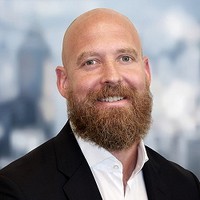Transcripts
 Erik: Joining me now is Peter Boockvar, Chief Investment Officer for Bleakly Advisory Group, Bleakly Financial Group, and the editor of the Boock Report, a very popular market newsletter.
Erik: Joining me now is Peter Boockvar, Chief Investment Officer for Bleakly Advisory Group, Bleakly Financial Group, and the editor of the Boock Report, a very popular market newsletter.
Peter, thanks so much for joining us this week. I want to start with the big-picture macro. You know, we’ve had so many conflicting signals and so many different viewpoints.
How would you summarize this big picture? It seems like, on one hand, there’s a lot of good reasons, if you look at bond yields and so forth, to think that we’re seeing recession signals. Boy, the stock market didn’t get the memo if that’s the case.
How do you make sense of all these conflicting signals?
 Erik: Joining me now is Charlie McElligott head of US cross-asset macro strategy for Nomura.
Erik: Joining me now is Charlie McElligott head of US cross-asset macro strategy for Nomura.
Charlie, it’s great to have you back on the program. Listeners, we do have a small chart deck that Charlie prepared that will accompany this interview. You’ll find the download link in your Research Roundup email. [If you’re not yet registered, go to our home page at macrovoices.com and look for the red button that says Looking for the Downloads?]
Charlie, I want to start with the really big broad-stroke big picture, and then we’ll get into some of the details that you’ve been writing about in some of your daily notes.
When I first interviewed you more than a year ago, you were talking about late-cycle dynamics, the end of the economic cycle. And I don’t think you got anything wrong. I think you were spot on.
But now we are more than a year later and I think we are seeing that the economic cycle really is ending. But, boy, the stock market has just got this persistent bid.
What is going on here? And is it telling us that that late-cycle analysis was wrong? Or is it just that the dynamics have changed and the market can melt up no matter what the economy is doing?
 Erik: Joining me now is Keith McCullough, founder of Hedgeye Risk Management and one of the most popular guests that we’ve had on the show. Keith, it’s great to have you back. Now, our regular listeners already know that the guys at Hedgeye can be counted on for some of the best slide decks in the business. So, listeners, I strongly encourage you to download the slide deck which accompanies today’s interview. You can find the download link in your Research Roundup email. If you’re not yet registered, just go to our home page at macrovoices.com, look for the red button that says Looking for the Downloads? next to Keith’s picture on the home page.
Erik: Joining me now is Keith McCullough, founder of Hedgeye Risk Management and one of the most popular guests that we’ve had on the show. Keith, it’s great to have you back. Now, our regular listeners already know that the guys at Hedgeye can be counted on for some of the best slide decks in the business. So, listeners, I strongly encourage you to download the slide deck which accompanies today’s interview. You can find the download link in your Research Roundup email. If you’re not yet registered, just go to our home page at macrovoices.com, look for the red button that says Looking for the Downloads? next to Keith’s picture on the home page.
Keith, the first dozen slides or so in the slide deck talk about the process that you use at Hedgeye. And I can’t emphasize strongly enough the importance of process and having a process.
 Erik: Joining me now is HonTe Investments Chief Investment Officer, Alex Gurevich. And, of course listeners, you know Alex is a big fixed-income expert and interest rate guy. Obviously, Alex, we need to get deep on interest rates in today’s interview.
Erik: Joining me now is HonTe Investments Chief Investment Officer, Alex Gurevich. And, of course listeners, you know Alex is a big fixed-income expert and interest rate guy. Obviously, Alex, we need to get deep on interest rates in today’s interview.
But first, what’s on everybody’s mind is it was FOMC [Federal Open Market Committee] day.
Give us the rundown. Obviously a 25-point basis cut. What’s your perspective on what happened here? What does it mean? And how do we fit this in to the big picture?
Alex: Good to be back.
So, yes, today is FOMC day. And whenever we are in the middle of our cycle, or actually action cycle – that is right now in the middle of an easing cycle – every FOMC day is very important.
Not only in terms of what happens today, what exactly they do, but also people look for clues as to the next meeting. Because it’s not so easy for them to change course between meetings.
 Erik: Joining me now is Diego Parrilla, the portfolio manager with Quadriga Asset Managers. And a good friend and co-author with our good friend Daniel Lacalle. Daniel and Diego co-authored The Energy World is Flat: Opportunities from the End of Peak Oil published in 2014. And Diego is the sole author of The Anti-Bubbles: Opportunities Heading Into Lehman Squared and Gold’s Perfect Storm.
Erik: Joining me now is Diego Parrilla, the portfolio manager with Quadriga Asset Managers. And a good friend and co-author with our good friend Daniel Lacalle. Daniel and Diego co-authored The Energy World is Flat: Opportunities from the End of Peak Oil published in 2014. And Diego is the sole author of The Anti-Bubbles: Opportunities Heading Into Lehman Squared and Gold’s Perfect Storm.
Diego prepared an excellent slide deck to accompany today’s interview and I strongly encourage you to download it. Registered users will find the download link in your Research Roundup email. If you’re not yet registered, just go to our home page at macrovoices.com and look for the red button that says Looking for the Downloads? next to Diego’s picture.
Diego, thanks so much for joining us. I want to go ahead and jump right in with the investment thesis that you focus your work around. Of course, you co-authored that book with Daniel Lacalle with respect to The Energy World is Flat: Opportunities from the End of Peak Oil. And your new book is called The Anti-Bubbles. Tell us what those are about.
MACRO VOICES is presented for informational and entertainment purposes only. The information presented in MACRO VOICES should NOT be construed as investment advice. Always consult a licensed investment professional before making important investment decisions. The opinions expressed on MACRO VOICES are those of the participants. MACRO VOICES, its producers, and hosts Erik Townsend and Patrick Ceresna shall NOT be liable for losses resulting from investment decisions based on information or viewpoints presented on MACRO VOICES.
